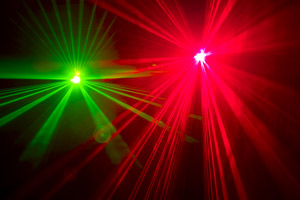Aug. 20, 2010 Research Highlight Physics / Astronomy
Lasers in a flash
Producing isolated laser pulses in just attoseconds made easier using a two-color laser field
 Figure 1: An artistic representation of light from two lasers. Conventional, two-color infrared laser beams can be used simply and reliably in systems designed to produce attosecond laser pulses. © 2010 iStockphoto/RapidEye
Figure 1: An artistic representation of light from two lasers. Conventional, two-color infrared laser beams can be used simply and reliably in systems designed to produce attosecond laser pulses. © 2010 iStockphoto/RapidEye
Ultrafast time-resolved laser spectroscopy is a technique that uses the interaction of light with matter to study the properties of physical systems. Researchers can generate laser pulses lasting mere attoseconds—quintillionths of seconds—to examine the nuclear dynamics in different states of matter, including single atoms.
Generating isolated attosecond pulses reliably is challenging. Commonly, physicists use few-cycle laser pulses with a near infrared wavelength as a pump to temporarily ionize specific atoms, typically those of a noble gas. When an electron re-collides with a nucleus from which it has been pulled away, it emits light with a much higher frequency than the one in the pump laser. This so-called ‘high-order harmonic generation’ usually in the extreme ultraviolet region can create an attosecond pulse.
Eiji Takahashi and his colleagues at the RIKEN Advanced Science Institute in Wako, in collaboration with scientists at the Vienna University of Technology, Austria, have now reported a way to easily produce isolated attosecond pulses, which surpasses all previous attempts for simplicity and reliability1.
A number of research groups have recently generated isolated laser pulses as short as 80 attoseconds. However, their energy is still too low be used in practice, since the energy of the pump pulses is limited. High pump energy would induce high gas ionization such that the atoms hit by the pump pulses would be highly ionized, but this would prevent the whole process of re-collision. In addition, to guarantee reliable production of isolated attosecond pulses, the phase of the carrier envelope wave connected to the pump pulse needs to be stabilized, which requires an expensive and complicated process.
To circumvent these limitations, Takahashi and colleagues used a two-color laser field: a pump laser with an 800-nanometer wavelength superimposed on one of 1,300 nanometers. The combination of the two lasers allowed the generation of a higher harmonic spectrum without needing to stabilize the carrier envelope phase.
Crucially, they used conventional lasers that are readily available and inexpensive (Fig. 1). “This novel two-color laser scheme also enables one to markedly suppress the detrimental gas target ionization,” notes Takahashi. “Consequently, not only the most appropriate phase-matching technique, but also an energy-scaling scheme, can be applied to produce intense isolated attosecond pulses.”
Takahashi also says that this method has the potential to produce isolated, attosecond, extreme-ultraviolet x-ray pulses with microjoule energy from a table-top system. He believes this would open the door to the realm of strongly nonlinear attosecond science.
References
- 1. Takahashi, E.J., Lan, P., Mücke, O.D., Nabekawa, Y. & Midorikawa, K. Infrared two-color multicycle laser-field synthesis for generating an intense attosecond pulse. Physical Review Letters 104, 233901 (2010). doi: 10.1103/PhysRevLett.104.233901
